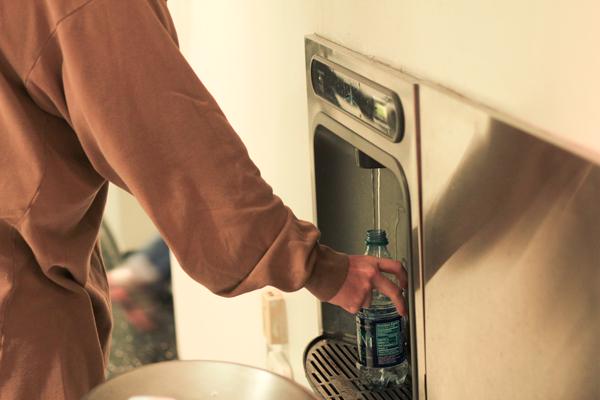Officials are declining to provide information on whether or not the University achieved one of its main water conservation goals almost five months after the deadline passed.
The University pledged to reduce spending on plastic water bottles by 50 percent by the end of fiscal year 2016, which ended in June, according to the GWater Plan. The next deadline in the plan is for total potable, or drinking and plumbing, water consumption by the University to be reduced by 25 percent by the end of fiscal year 2018.
These are two of eight water conservation goals in the GWater Plan, an ongoing water conservation plan University President Steven Knapp instituted in 2011. The program’s goal is to reduce GW’s effects on the Potomac and Anacostia rivers’ watersheds by 2021 by reducing water use, capturing rainwater and reducing contaminants in campus water.
The GWater plan was touted as “one of the most comprehensive plans for water sustainability issued by an American university,” at the time of its publication on Earth Day in 2011, according to the Office of Sustainability’s website. But without progress reports or publicly available data, experts say it is difficult to determine whether officials will be able to accomplish the plan’s goals.
University spokesman Timothy Pierce declined to comment on how much water GW used last year.
Pierce said GW has made progress in reducing water usage by adding water-efficient upgrades to faucets, shower heads and toilets in academic and residence buildings.
Sustainability is considered in all new construction projects and renovations on campus, which are built based on environmental standards set by the U.S. Green Building Council, he said. Since 2010, GW has constructed 12 Leadership in Energy and Environmental Design buildings, including District House, which opened in August. Pierce said the LEED standards for water-efficient plumbing result in a 30 to 40 percent decrease in water usage University-wide.
In 2013, GW started renovating older residence halls on campus, but only some of those renovations included replacing old bathroom fixtures with water-efficient appliances, according to the GW Housing website. Residence halls and academic buildings make up for 63 percent of water use on campus, according to the GWater Plan.
The University has been reducing plastic water use by requiring water bottle spigots to be installed with new drinking fountains. The Green Office Certification program, run by the Office of Sustainability, also encourages offices to eliminate using bottled water.
GW installed water fountain filters in the law school in lieu of the usual plastic water coolers in 2011 and started a reusable water bottle rental program in 2012.
Pierce declined to comment on how much money University programs spent on bottled water last year and the year the GWater Plan was implemented.
“Currently, GW is conducting an inventory of water fountains and bottle fillers across the campuses,” Pierce said. “Using tap water reduces costs and pollution associated with the bottling and shipping of bottled water.”
Experts said that although the goals in the water conservation plan are attainable, the sustainability office should be transparent about water usage to encourage the campus community to reach those goals.
Mark Gold, the associate vice chancellor of environment and sustainability at the University of California at Los Angeles, said monitoring water usage and making the data visible helps community members be aware of their water usage.
“Metering all your buildings so that the real-time water use is known is something I think is very important,” Gold said. “If you know how much water you’re using, you’re going to use less.”
Research universities like UCLA and GW face the unique challenge of attempting to reduce potable water use in on-campus buildings like hospitals, Gold said. He suggested those facilities should start recycling water and using less potable water.
Upmanu Lall, the director of the Columbia Water Center at Columbia University, said active student participation is key to conserving potable water.
Students have spearheaded water conservation projects across campus in the past few years. The Department of Energy and Environment awarded $5,900 to the GroW Garden, a student organization, to install a rainwater collection system in July. And past candidates for Student Association leadership positions have included the addition of more water bottle fillers on campus in their platforms.
For the University to reach its water conservation goals, students need to actively participate by using less water in their everyday lives, Lall said.
“The next step, really, is behavior change on the part of the population,” Lall said.







